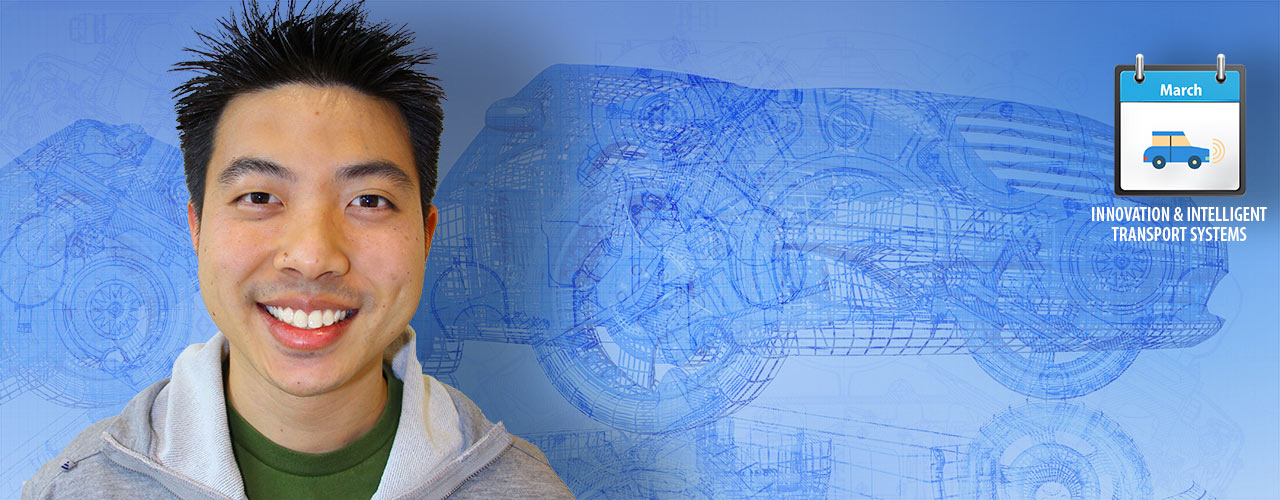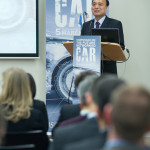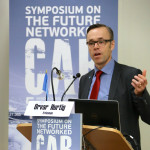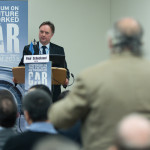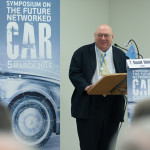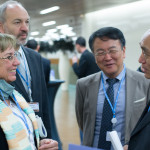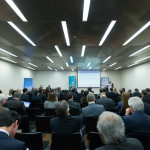Cityscapes may be redefined by 2025 with the introduction of driverless technology designed to reduce traffic and improve road safety. Dr James Fu and the Singapore-MIT Alliance for Research and Technology team are working to innovate automotive technology and change the way we commute.
There are many reasons to own a car; they provide drivers with greater mobility and independence, and for some can even act as a status symbol. These reasons, coupled with increasing affordability and availability, have led to a rapid growth in car ownership – in 2010 there were 1.015 billion cars worldwide, but it is predicted that there will be 1.7 billion on the road by 2035. This growth will adversely affect travel time, with the average commuter in the United States of America already spending 38 hours a year stuck in traffic, a surprising statistic considering that the average car is used less than 10% of the time. These additional vehicles will also compound current safety statistics: there are 1.24 million road traffic deaths per year worldwide, with drink driving and distracted driving, such as texting while driving, leading causes of road traffic accidents. Changes need to be made in automotive technology both to meet this growing demand and improve road safety while maintaining the freedoms associated with car ownership.
I finished my PhD in mechanical engineering at the National University of Singapore (NUS), developing a framework to allow multiple agents (or robots) to perform multiple tasks in a globally efficient manner. This enabled me to join the Singapore-MIT Alliance for Research and Technology (SMART) Future Urban Mobility research group – a collaboration between the Massachusetts Institute of Technology (MIT) and NUS, composed of a mix of Professors, postdocs, research engineers and PhD students – as a Postdoctoral Associate in 2013. I have since become the Project Lead of the autonomous vehicles group.
Our work focuses on developing the intelligence and decision making behind the smart vehicle – i.e. how does the vehicle interpret the environment, how can it tell if an object is moving towards it and act accordingly? The research integrates existing technologies with new methodologies to facilitate intelligent navigation through three fundamental elements – perception, planning and control. We have faced many technical challenges, both hardware and software, yet to me, this is the most interesting part of the project as it is very satisfying when the team and I come up with new methods which work robustly.
Reducing Driver Distractions with ICTs
“Under the banner of Intelligent Transport Systems (ITS), the automotive and ICT communities are working towards a convergence of automobiles and ICTs that prioritizes drivers’ safety and broad consensus has it that international standards are the tools through which this will be achieved. (…) For two years from 2011 – 2013, the ITU-T Focus Group on Driver Distraction lay the foundations for driver-distraction standardization work in ITU’s Telecommunication Standardization Sector (ITU-T).” Read more here.
Felipe Massa Road Safety Message
Formula-1 champion driver, Felipe Massa visited ITU HQ for World Telecommunication and Information Society Day 2013. To highlight the theme ‘ICTs and Improving Road Safety’, Massa used a simulator to show how distractions can affect even the most talented professional driver. Listen to him talk about the importance of safe driving here.
ITU Academic Membership
As ITU Academia Members, universities from around the world share their expertise and help shape the development of ICT standards and regulation. Learn more here.
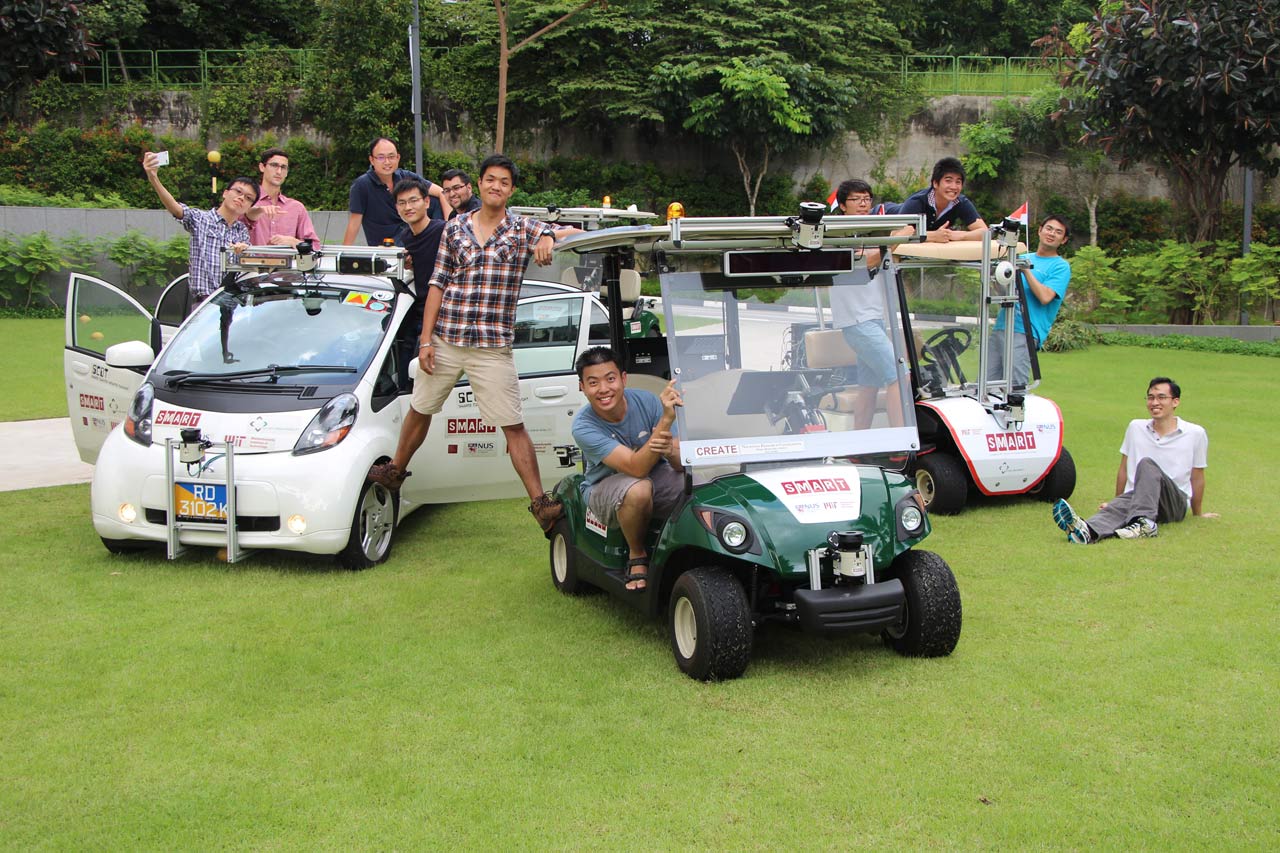
Driverless cars represent a paradigm shift in how we understand transportation, both technologically and socially. However, realizing an autonomous future rests on a number of key factors such as culture, political will, raising public awareness and gaining user acceptance.
How it Works: The Technology
Developed over six months, hardware and software architecture used on the driverless golf buggy was replicated onto the Shared Computer Operated Transport (SCOT), an electric car converted into a driverless vehicle for use on public roads. It provides Mobility on Demand (MoD), a simple concept whereby intelligent electric vehicles drive independent from human interference, stopping to pick up and drop off passengers. It is a flexible transport system, balancing demand with real-time planning.
Getting into the car for the first time was incredible; relinquishing control to the car was a little surreal, but it was an incredible feeling both to have created the technology and to see it work on the road – the team and I were over the moon!
The first major challenge was converting the vehicle from manual drive to ‘drive by wire’, where the main actuation functions of the vehicle (steering, braking, throttle, and gear shift) are controlled through electrical signals. This is done using electric motors.
The car was then retrofitted with off-the-shelf Light Detection and Ranging (LIDAR) sensors. At USD 30,000 for sensors and on-board computers, the technology is not only low cost but provides a 360 degree field of view – compared to humans’ 100 degree field of vision – to give information about objects around the vehicle. Maps of the environment are built with LIDAR sensor data and the on-board computers use SMART developed algorithms to understand the 3D environment using the 2D LIDAR scans.
A tilted-down LIDAR is mounted on the roof, enabling it to detect its current location; logging a user input destination, the car plans a route based on its current location and the pre-built map. A forward facing sensor is used to detect obstacles, e.g., pedestrians and other vehicles. A predictor is used to determine if a dynamic obstacle would come into the car’s path, allowing the car to manoeuvre appropriately based on the obstacle’s proximity.
This enhances pedestrian and passenger safety while enabling the car to navigate dense and heavily populated areas, tunnels and places where Global Positioning System (GPS) signals are otherwise hindered. LIDAR sensors also operate in poor lighting and moderate rain.
Once fitted with this technology, the car can seat up to four passengers and has currently been tested at autonomous speed on roads of up to 35 km/h. On a full charge, which takes 6 – 8 hours, the car has a range of 100 – 130 km.
ITU Standards (ITS)
Through our ITU-T Study Groups, ITU has been leading worldwide efforts in developing state-of-the-art ICT standards for intelligent transport systems (ITS) and driver safety that utilize a combination of computers, communications, positioning and automation technologies, including in-car radars for collision avoidance. ITU has also been developing standards for safe user interfaces and communication systems in vehicles as well as optimizing driving performance by eliminating unsafe technology-related distractions while driving.
The allocation of dedicated spectrum to intelligent transport systems is the subject of a proposal on the agenda of the World Radiocommunication Conference in 2015 (WRC-15).
ITU’s unique public-private partnership of members and tradition of consensus-driven decision-making as providing the right environment for multi-stakeholder discussion of the role of ICT in improving road safety.
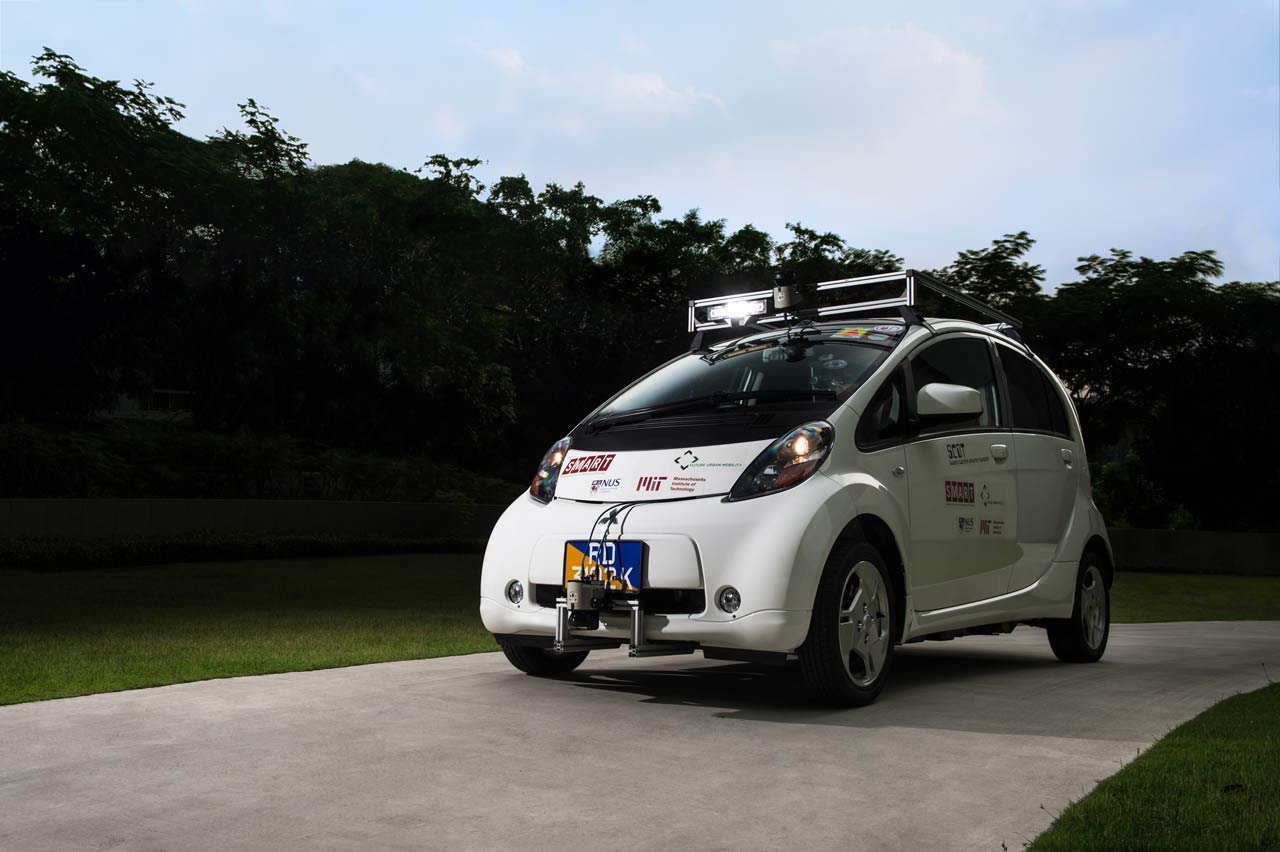
What are the Advantages of Driverless Cars?
I believe that the deployment of driverless vehicles will make the transport system more efficient while improving safety. First and foremost, driverless cars can solve the ‘first and last mile problem’, i.e. the distance between the house and the start of the transport network, such as the bus stop or train station, and from the end of the transport network to the office. It also addresses the ‘rebalancing issue’, i.e. getting a car to the next car-sharing customer from the previous customer without needing a driver.
Simulations also show that twice as many driverless cars can go through intersections as regular cars which can ease congestion – especially during peak hours – and reduce greenhouse gas (GHG) emissions caused by stop and start driving. However, the largest benefit of driverless technology is the ability to serve multiple customers at once with intelligent routing, reducing the number of cars on the road by an estimated two thirds.
The technology also revolutionizes road safety. Computers do not have emotions, get tired at the wheel, get distracted by a mobile phone or drive aggressively: this can significantly reduce car fatalities. On-board sensors detect when a person runs in front of the driverless car and immediately perform an emergency stop. Accessibility is also another benefit; people who were previously blocked out of car ownership and use such as the elderly, disabled or young, can have easy access to mobility.
Above all, the autonomous car offers a better user experience.
2014 Future Networked Car Symposium
Tiff Needell, former Formula-1 driver and presenter of TV programme Fifth Gear, moderated the high-level dialogue on ‘Innovation for the Future Car’ at the 2014 ITU Future Networked Car Symposium. He spoke to the audience about the evolution of motor vehicles and their future trajectory.
Listen to the full session here.
Pilot – Chinese and Japanese Gardens, Singapore
Most of the research work has been done on the NUS campus. An autonomous golf cart was successfully introduced in 2011, and the fleet was expanded in 2014 to include an electric car and two additional driverless buggies.
To better understand the opportunities and challenges associated with driverless technology, SMART deployed two autonomous golf buggies fitted with SMART technology to the Chinese and Japanese gardens in Jurong Lake District in Singapore. The pilot allowed us to showcase the technology, demonstrate the concept of MoD, and increase public awareness. For six days over two weekends from 23 October to 1 November 2014, we saw how passengers and pedestrians interacted with the technology. People could book a ride to and from 10 pre-determined locations via an online booking system. Vehicle-to-vehicle communication allowed the golf buggies to intelligently select routes by enabling them to locate each other to avoid overlapping paths to ensure efficient deployments.
We originally intended the buggies to pick-up and drop-off around 100 people. In fact, the vehicles carried more than 500 people in over 220 trips across 360km – there were times when people waited up to two hours just to take a ride. Sufficed to say that the public demonstration was incredibly popular! It was really rewarding to see the technology being used by so many and to have such positive feedback, with many people saying that they hope to see at as part of the transport system one day.

Future Objectives and Commercial Availability
I strongly believe that the deployment of driverless cars will benefit society and increase quality of life, especially in densely populated areas such as Singapore. Yet, though the pilot test in the Chinese and Japanese Gardens was very positive, it is hard to predict when driverless vehicles will become a reality on a large scale as there are many components involved. The environment must be ready for their integration; governments must be forward-looking to incorporate the necessary technology into society, such as charging stations and network infrastructures that enable connectivity between vehicles and people, and make the required changes to future planning of cities.
There is a need to raise public awareness to ensure that people feel comfortable with driverless technology, both as passengers and pedestrians. The challenge is to communicate the enhanced safety aspects associated with autonomous cars together with the loss of single vehicle ownership. Cars will operate as part of a public transport network, whereby people can request or ‘hail’ a car through an online application: once the car has taken you to your destination, it will go and pick up another waiting passenger. It is predicted that the constant mobility of autonomous vehicles will reduce the number of cars on the road to one-third of what we have now. Therefore, we are currently identifying how the technology can be scaled up efficiently and effectively.
Singapore is actively looking into how autonomous vehicles can be integrated into the transportation system – it is a hyper-dense city, at 700km2 with 5.5 million residents and over 974,000 vehicles on the road in 2013. With the recent announcement of the One-North area as an open test-bed for autonomous vehicles, our group’s next step is to test our vehicle’s current capabilities and to further the research work on public roads. On-going research deployments such as these will enable us to improve responses to anticipated pedestrian behaviour, and further develop the vehicle’s understanding of, and response to, road infrastructures such as lane markings, traffic and right of way.
Overall, I hope we can see some form of initial deployment within the next three years, and I hope that society will have driverless vehicles seemingly integrated into the transportation system by 2025. There is still a long way to go, but we are getting there.
2015 Future Networked Car Symposium
Future Networked Car 2015
ITU and UNECE convened the 10th edition of the Future Networked Car Symposium at the Geneva Motor Show on 5 March 2015. Intelligent transport systems and automated driving are fast moving towards widespread commercialization and market acceptance. High levels of automation – the penultimate step to fully automated driving – are expected on the road by 2020 and hold great promise to improve road safety, reduce congestion and emissions, and increase the accessibility of personal mobility to the elderly and persons with disabilities.
The Symposium on The Future Networked Car brought together representatives of the automotive and information and communication technology (ICT) industries, governments and their regulators, motor sport and international automobile associations to discuss the status and future of ICTs’ integration in vehicles.
The international symposium examined advances in the area of connected vehicles, from the perspectives of business, technology and regulation. Technical sessions highlighted the crucial roles of communication protocols, information security, in-vehicle emergency call systems, location referencing and maps.

